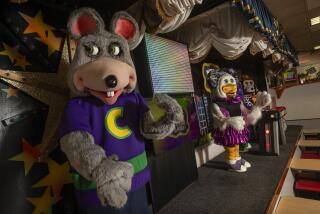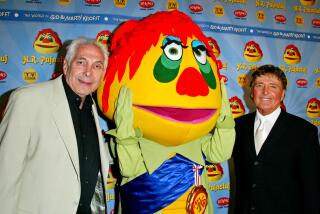Working Hollywood: Making mice for ‘Dinner for Schmucks’
- Share via
The Chiodo brothers — Stephen, Edward and Charles — recently crafted more than 100 model mice for the new Steve Carell-starring comedy “Dinner for Schmucks,” but it was a great ape that initially set them on a path to filmmaking: The New York natives as children made 8-millimeter stop-motion animated movies in their parents’ basement, inspired by the work of special effects legends Ray Harryhausen and Willis O’Brien.
“When we went to one of our first trips to New York City after seeing 1933’s ‘King Kong,’ we were at the Empire State Building looking for the cracks in the sidewalk where he might have fallen,” said Charles.
In college, all three pursued creative degrees: Edward in theater arts and photography, Stephen in photography and filmmaking, and Charles in illustration. Stephen and Charles explored the filmmaking scene in New York and Washington, D.C., before moving to Los Angeles in 1980 and founding a company. Edward joined them in Los Angeles in 1984 after finishing school.
Since then, they’ve created effects and characters for films including 1985’s “Pee-wee’s Big Adventure,” 1986’s “Critters,” 2003’s “Elf” and 2004’s “Team America: World Police.” They also wrote, produced and directed 1988’s “Killer Klowns From Outer Space” and currently are developing a sequel.
“We give our characters a life that you might not get someplace else,” said Charles. “That’s our Frankenstein complex: We’re bringing life to things.”
Classics reinterpreted: For “Dinner for Schmucks,” the Chiodo brothers are credited with creating the film’s “mousterpieces and dioramas.” “Steve Carell plays a character whose idiosyncrasy is building mice dioramas: basically great moments in history told with mice,” said Stephen. “These guys like Benjamin Franklin and the Wright Brothers and Louis Pasteur — these were all mice dioramas we made. Then on top of that, we had to do the mousterpieces. So we have the ‘Mona Lisa.’ We have Michelangelo’s ‘Creation of Adam.’ ‘American Gothic.’ We did ‘Scream.’ All of these classic art masterpieces are re-created by Steve Carell’s character with mice. We had the references, and we had to match all the details.”
Natural habitat: Carell’s society also includes more ordinary mouse citizens. “At a certain point, we see his garage workshop, and they reveal Mouseland,” explained Stephen. “The filmmakers wanted a Central Park feel, but because it’s L.A., I think MacArthur Park became the image. We had to give it green grass, flowers, bushes, a lake with a bridge, palm trees and then the little vignettes of action that they wanted.” Charles added, “We were using railroad miniature parts and railroad scenic devices. We used fun fur that we painted for the grass. So it was a lot of old-school, simple techniques to create this wonderland.” But it wasn’t all prefab. “We had to custom make certain things that didn’t exist in the scale,” explained Edward, “like a Ferris wheel and a playground spinner.”
Mouse trappings: The Chiodo brothers’ mice were head and shoulders above the real thing. “They’re a little bigger than regular mice, because when we looked at real mice, they’re tiny little things,” said Charles. “We would have compounded the difficulty factor by doing actual scale mice. Making the clothing and the props would have been that much more difficult. Their whiskers were single hairs from a very fine paintbrush. To do a sculpt on a real mice hand would have been impossible. They’re tiny. The fingers are the thickness of a pin. Imagine jewelry, the ring on that little finger, the shoe. So we scaled them up slightly.” As Edward explained, “The most useful tool on this job was everybody’s little Magnascope glasses.”
Of man and mice: The Chiodo brothers did their part to hasten the evolution of the diminutive species in other ways as well. “If they were straight taxidermied mice, they were kind of icky and creepy looking,” said Stephen. “There’s nothing adorable or approachable about them. And because this is really a window into Steve Carell’s character in the film, they had to be engaging, empathetic and sort of cute. I sculpted the mice, and in the first attempts, we tried to do it realistically, and it just didn’t work. So we started talking. ‘We’ll make their eyes bigger. Let’s make their arms and legs a little longer. Let’s give them shoulders so they can wear jackets.’ And they became a little anthropomorphic, but they still are mice. And I think that’s part of their success.”
More to Read
The biggest entertainment stories
Get our big stories about Hollywood, film, television, music, arts, culture and more right in your inbox as soon as they publish.
You may occasionally receive promotional content from the Los Angeles Times.










